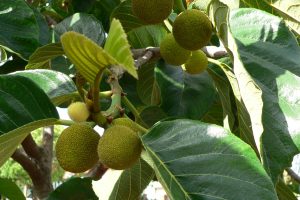Artocarpus lacucha(lakoocha)
Lakoocha, monkey jak, red jakfruit
Origin
This species is native to India and also commonly found through Malaysia, Vietnam, Sri Lanka and Nepal.
Climate
Lakoocha is a tropical to sub-tropical plant which prefers a humid environment and is damaged by frost, particularly when young.
Plant Description
It is a small attractive deciduous tree, 5-9m tall, with a spreading crown. The elliptical leaves are alternate and leathery, 10-25cm long.
Relatives
Moraceae Family, which also includes jackfruit, chempedak, kwai muk, fig and mulberry.
Soils
The tree is commonly found along stream banks, doing best in deep permeable soils and less so on poor sites. Although moist soils are preferred, it cannot stand waterlogging.
Propagation
Seeds and cuttings are the usual means of propagation. The recalcitrant seeds germinate readily in a few weeks if sown while fresh and without drying, The young seedlings should be protected from full sun for the first few months. If using cuttings, these should be about 5cm long with at least three buds.
Cultivars
Little selection has so far been done with monkey jack and there are no established cultivars. Seedlings can have considerable variation in fruit quality between trees and in different localities.
Flowering and Pollination
Flowers occur terminally and in leaf axils of new growth with separate male and female flowers on the one plant (monoecious); these are spherical with the orange male flowers being smaller than the female. It is thought that pollination is achieved by insects which are attracted by the fragrant flowers.
Cultivation
Fertilizer requirements have not been systematically studied. Generally low maintenance.
Wind Tolerance
Sites chosen for planting should be protected from strong winds.
Pruning
Minimal, with some shaping of the main framework branches when young.
The Fruit
The fruit is a syncarp with multiple united carpels in a compound ovary, and can weigh up to 300g. It has a nobbly skin and is often irregularly shaped depending on the extent of pollination, with a change from green while young to a darkish yellow when ripe. Flesh is a deep yellow/orange colour with a sweet to acid flavour, and a pleasant tangy citrus taste similar to kwai muk fruit. Seeds are up to 1cm long.
Fruit Production and Harvesting
Seedlings may take 4-5 years to come into bearing. Fruit take about four months to mature, with cropping during autumn in a sub-tropical climate such as Perth. They are ripe when colour changes to a dull yellow with a pinkish tinge. Fruits should be picked from the tree rather than allowing them to fall, as by then they’re beginning to ferment. Mature trees can produce good yields of up to 60kg/tree.
Fruit Uses
The pulp including skin and seeds is eaten fresh, used in making curries, pickles and chutney, or dried and used as a substitute for tamarind and mango. It has very good levels of Vitamins A and C. The flowers can also be eaten raw, boiled, steamed or roasted.
Pests and Diseases
Birds can be a problem, otherwise minimal.
Comments
Lakoocha is an attractive tree that copes quite well in Perth’s environment. To date it has received little developmental work.

